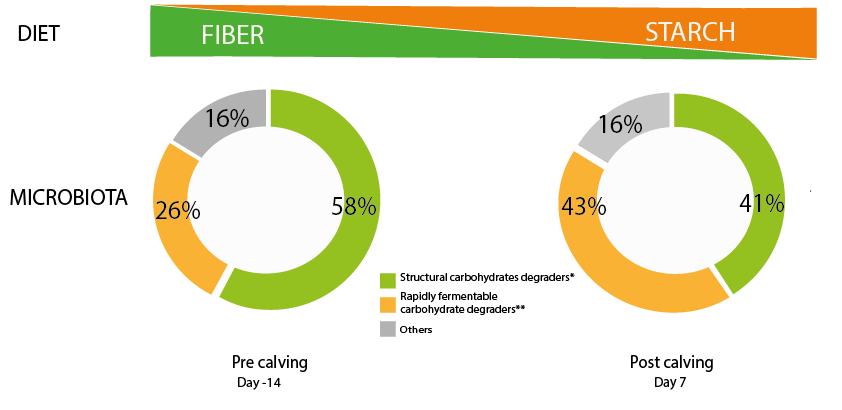Blog | Reading Time 4 minutes
Dairy cow transition challenges the rumen microbiota
New insights from metagenomics studies
Confirming the protective role of Saccharomyces cerevisiae CNCM I-1077
In 2018, breakthrough research was published in the Journal of Dairy Science, detailing the effects of the calving transition on the rumen epithelium.1 This study has been supplemented with metagenomics data, confirming the association between changes in the rumen microbiota and feed efficiency improvements around calving, as well as the protective role of Saccharomyces cerevisiae CNCM I-1077 to help the cows face this challenging period.2
The trial
The transition period in dairy cows spans three weeks pre-calving to three or four weeks following calving. It represents a critical time for the cow with major dietary, metabolic and physiological changes. In particular, the transition from a high-fiber diet to a diet high in rapidly fermentable carbohydrates represents important challenges for rumen health. It can also have a negative impact on the cow’s inflammatory status. A trial was conducted in partnership with Professor Alex Bach’s team (IRTA, Spain) at the Blanca Experimental Farm (Spain), on the impact of transition challenges on rumen health and microbiota profiles as well as the effect of live yeast.
The trial was conducted on 21 Holstein dairy cows from 21 days before calving until 21 days after calving. The diet changed from 28% concentrate before calving (51.2% neutral detergent fiber, NDF, 13.2% crude protein, CP) to 64% concentrate after calving (34.8% NDF, 15.2% CP).
Understanding metagenomics data
Metagenomics is the genetic identification of the whole microbiota of a host and their relative abundance. These technologies generate millions of genetic sequences. Thanks to biostatistics analysis, this data could be pooled together according to bacteria genus — which shows more than a hundred different bacteria types (Figure 1). Such analysis can help microbiologists have a better understanding of the complex composition of the microbiota, like that found in the rumen.
In the case of transition cows, the goal was to focus on the relative abundance of functionally relevant bacteria. Results from two main categories of microbes were combined: bacteria that degrade complex carbohydrates, such as fiber; and bacteria that degrade rapidly fermentable carbohydrates, like starch (Figure 2).
The data shows that:
- Before calving, the relative proportion of the fiber-degrading bacteria is higher than the ones thriving on rapidly fermentable carbohydrates.
- Post-calving, there is a rapid shift towards a higher proportion of bacteria degrading rapidly fermentable carbohydrates.
Protective role of live yeast
The first part of the study published in 20182 showed that feeding S. cerevisiae CNCM I-1077 from three weeks pre-calving positively improved the rumen dynamics by:
- Reinforcing rumen epithelium integrity, thanks to higher tight junction gene expression before the challenge.
- Increasing resistance to a LPS challenge leading to a lower inflammation after calving
The metagenomics data further indicate the protective role for the live yeast:
- Pre-calving, the relative proportion of fiber-degrading populations is significantly higher (P<0.05).
- Post calving, the live yeast group showed higher dry matter intake, leading to a 1.21 kg/day increase in non-fiber carbohydrates. This would have negatively impacted rumen pH and microbial balance leading to a higher proportion of rapidly carbohydrate degraders. Instead, there was no statistical difference with the control group that consumed less fermentable carbohydrates.
Dr. Bach explains: “Because LEVUCELL SC cows consumed more feed, a lower rumen pH and greater relative abundance of Prevotella (rapidly fermentable carbohydrate degrader) would have been expected, unless LEVUCELL SC had exerted a positive effect on rumen pH.”
In conclusion, the live yeast — by stabilizing the rumen pH despite a higher non-fiber intake — limits the burst of rapidly fermentable carbohydrates degraders.
Published Dec 13, 2019 | Updated May 30, 2023
Related articles
Need specific information?
Talk to an expert
